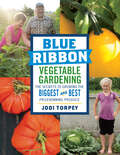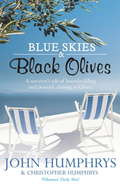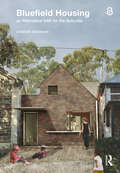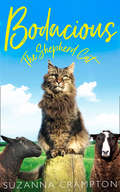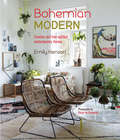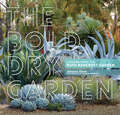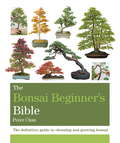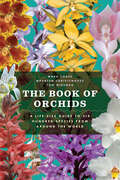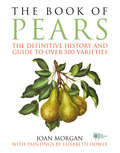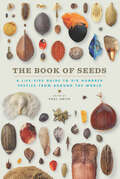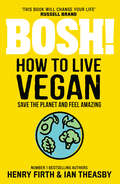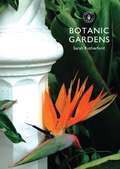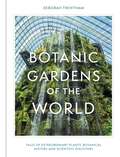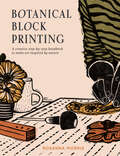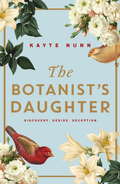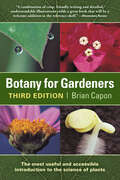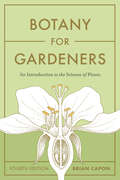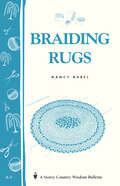- Table View
- List View
Blue Ribbon Vegetable Gardening: The Secrets to Growing the Biggest and Best Prizewinning Produce
by Jodi TorpeyFor many, vegetable gardening is a sport, and the competition is an irresistible incentive, whether it's at the state fair or with the neighbor next door! Blue-Ribbon Vegetable Gardening reveals the secrets to growing the biggest, tastiest, most beautiful vegetables ever.
Blue Skies & Black Olives: A Survivor's Tale Of Housebuilding And Peacock Chasing In Greece
by John Humphrys Christopher HumphrysRadio 4 Today presenter and national treasure John Humphrys’ funny and engaging memoir of building a home in Greece with his son Christopher.
Bluefield Housing as Alternative Infill for the Suburbs
by Damian MadiganSuburbanised cities share a common dilemma: how to transition to more densely populated and socially connected urban systems while retaining low-rise character, avoiding gentrification, and opening neighbourhoods to more diverse housing choices. Bluefield Housing offers a new land definition and co-located infill model addressing these concerns, through describing and deploying the types of ad-hoc modifications that have been undertaken in the suburbs for decades. Extending green-, brown-, and greyfield definitions, it provides a necessary middle ground between the ‘do nothing’ attitude of suburban preservation and the ‘do everything’ approach of knock-down-rebuild regeneration.An adjunct to ‘missing middle’ and subdivision densification models, with a focus on co-locating homes on small lots, Bluefield Housing presents a unified design approach to suburban infill: retrofitting original houses, retaining and enhancing landscape and urban tree canopies, and delivering additional homes as low-rise additions and backyard homes suited to the increasingly complex make-up of our households.Extensively illustrated by the author with engaging architectural design studies, Damian Madigan describes how existing quirks of suburban housing can prompt new forms of infill, explains why a new suburban densification model is not only necessary but can be made desirable for varied stakeholders, and charts a path towards the types of statutory and market triggers required to make bluefield housing achievable. Using Australian housing as an example but addressing universal concerns around neighbourhood character, demographic needs, housing diversity, dwelling flexibility, and landscape amenity, Bluefield Housing offers innovative suburban infill ideas for policy makers, planners, architects, researchers and students of housing and design studies, and for those with a stake in the future of the suburbs.The Open Access version of this book, available at www.taylorfrancis.com, has been made available under a Creative Commons Attribution-Non Commercial-No Derivatives (CC-BY-NC-ND) 4.0 license.
Bluefield Housing as Alternative Infill for the Suburbs
by Damian MadiganSuburbanised cities share a common dilemma: how to transition to more densely populated and socially connected urban systems while retaining low-rise character, avoiding gentrification, and opening neighbourhoods to more diverse housing choices. Bluefield Housing offers a new land definition and co-located infill model addressing these concerns, through describing and deploying the types of ad-hoc modifications that have been undertaken in the suburbs for decades. Extending green-, brown-, and greyfield definitions, it provides a necessary middle ground between the ‘do nothing’ attitude of suburban preservation and the ‘do everything’ approach of knock-down-rebuild regeneration.An adjunct to ‘missing middle’ and subdivision densification models, with a focus on co-locating homes on small lots, Bluefield Housing presents a unified design approach to suburban infill: retrofitting original houses, retaining and enhancing landscape and urban tree canopies, and delivering additional homes as low-rise additions and backyard homes suited to the increasingly complex make-up of our households.Extensively illustrated by the author with engaging architectural design studies, Damian Madigan describes how existing quirks of suburban housing can prompt new forms of infill, explains why a new suburban densification model is not only necessary but can be made desirable for varied stakeholders, and charts a path towards the types of statutory and market triggers required to make bluefield housing achievable. Using Australian housing as an example but addressing universal concerns around neighbourhood character, demographic needs, housing diversity, dwelling flexibility, and landscape amenity, Bluefield Housing offers innovative suburban infill ideas for policy makers, planners, architects, researchers and students of housing and design studies, and for those with a stake in the future of the suburbs.The Open Access version of this book, available at www.taylorfrancis.com, has been made available under a Creative Commons Attribution-Non Commercial-No Derivatives (CC-BY-NC-ND) 4.0 license.
Bodacious: The Shepherd Cat
by Suzanna CramptonBODACIOUS: THE SHEPHERD CAT is a heart-warming and charming tale in which Bodacious tells us about life as The Shepherd Cat on Black Sheep Farm.
Bohemian Modern: Imaginative And Affordable Ideas For A Creative And Beautiful Home
by Emily HensonEmily Henson explores the elements that come together to create this eclectic, colourful and contemporary look and draws inspiration from an array of real-life Bohemian Modern homes.
The Bold Dry Garden: Lessons from the Ruth Bancroft Garden
by Johanna SilverA Publishers Weekly Best Book of 2016 In the stunning pages of The Bold Dry Garden you&’ll discover the history of the acclaimed garden along with the design principles and plant palette to create your own lush, low-water landscapes.
The Bonsai Bible: The definitive guide to choosing and growing bonsai (Octopus Bible Ser.)
by Peter ChanThe Japanese and Chinese have been creating bonsai trees for centuries and it is now an internationally popular pastime. This compact and stylish guide will provide everything you need to know to grow bonsai successfully, including shaping with wires, watering, seasonal maintenance, tackling common ailments, choosing the right container, feeding and repotting. A directory of over 90 of the most popular species, illustrated with beautiful photographs, will enable you to find the tree that is right for you.
The Book of Orchids: A Life-Size Guide to Six Hundred Species from around the World (Book Of Ser.)
by Mark W. Chase Maarten J. Christenhusz Tom MirendaOne in every seven flowering plants on earth is an orchid. Yet orchids retain an air of exotic mystery—and they remain remarkably misunderstood and underappreciated. The orchid family contains an astonishing array of colors, forms, and smells that captivate growers from all walks of life across the globe. Though undeniably elegant, the popular moth orchid—a grocery store standard—is a bland stand-in when compared with its thousands of more complex and fascinating brethren, such as the Demon Queller, which grows in dark forests where its lovely blooms are believed to chase evil forces away. There is the Fetid Sun-God, an orchid that lures female flies to lay their eggs on its flowers by emitting a scent of rancid cheese. Or the rare, delicate Lizard Orchid, which mimics the appearance of lizards but smells distinctly of goat. The Book of Orchids revels in the diversity and oddity of these beguiling plants. Six hundred of the world’s most intriguing orchids are displayed, along with life-size photographs that capture botanical detail, as well as information about distribution, peak flowering period, and each species’ unique attributes, both natural and cultural. With over 28,000 known species—and more being discovered each year—the orchid family is arguably the largest and most geographically widespread of the flowering plant families. Including the most up-to-date science and accessibly written by botanists Mark Chase, Maarten Christenhusz, and Tom Mirenda, each entry in The Book of Orchids will entice researchers and orchid enthusiasts alike. With stunning full-color images, The Book of Orchids is sure to become the go-to reference for these complex, alluring, and extraordinarily adaptable plants.
The Book of Orchids: A Life-Size Guide to Six Hundred Species from around the World
by Mark W. Chase Maarten J. Christenhusz Tom MirendaOne in every seven flowering plants on earth is an orchid. Yet orchids retain an air of exotic mystery—and they remain remarkably misunderstood and underappreciated. The orchid family contains an astonishing array of colors, forms, and smells that captivate growers from all walks of life across the globe. Though undeniably elegant, the popular moth orchid—a grocery store standard—is a bland stand-in when compared with its thousands of more complex and fascinating brethren, such as the Demon Queller, which grows in dark forests where its lovely blooms are believed to chase evil forces away. There is the Fetid Sun-God, an orchid that lures female flies to lay their eggs on its flowers by emitting a scent of rancid cheese. Or the rare, delicate Lizard Orchid, which mimics the appearance of lizards but smells distinctly of goat. The Book of Orchids revels in the diversity and oddity of these beguiling plants. Six hundred of the world’s most intriguing orchids are displayed, along with life-size photographs that capture botanical detail, as well as information about distribution, peak flowering period, and each species’ unique attributes, both natural and cultural. With over 28,000 known species—and more being discovered each year—the orchid family is arguably the largest and most geographically widespread of the flowering plant families. Including the most up-to-date science and accessibly written by botanists Mark Chase, Maarten Christenhusz, and Tom Mirenda, each entry in The Book of Orchids will entice researchers and orchid enthusiasts alike. With stunning full-color images, The Book of Orchids is sure to become the go-to reference for these complex, alluring, and extraordinarily adaptable plants.
The Book of Orchids: A Life-Size Guide to Six Hundred Species from around the World
by Mark W. Chase Maarten J. Christenhusz Tom MirendaOne in every seven flowering plants on earth is an orchid. Yet orchids retain an air of exotic mystery—and they remain remarkably misunderstood and underappreciated. The orchid family contains an astonishing array of colors, forms, and smells that captivate growers from all walks of life across the globe. Though undeniably elegant, the popular moth orchid—a grocery store standard—is a bland stand-in when compared with its thousands of more complex and fascinating brethren, such as the Demon Queller, which grows in dark forests where its lovely blooms are believed to chase evil forces away. There is the Fetid Sun-God, an orchid that lures female flies to lay their eggs on its flowers by emitting a scent of rancid cheese. Or the rare, delicate Lizard Orchid, which mimics the appearance of lizards but smells distinctly of goat. The Book of Orchids revels in the diversity and oddity of these beguiling plants. Six hundred of the world’s most intriguing orchids are displayed, along with life-size photographs that capture botanical detail, as well as information about distribution, peak flowering period, and each species’ unique attributes, both natural and cultural. With over 28,000 known species—and more being discovered each year—the orchid family is arguably the largest and most geographically widespread of the flowering plant families. Including the most up-to-date science and accessibly written by botanists Mark Chase, Maarten Christenhusz, and Tom Mirenda, each entry in The Book of Orchids will entice researchers and orchid enthusiasts alike. With stunning full-color images, The Book of Orchids is sure to become the go-to reference for these complex, alluring, and extraordinarily adaptable plants.
The Book of Orchids: A Life-Size Guide to Six Hundred Species from around the World (Book Of Ser.)
by Mark W. Chase Maarten J. Christenhusz Tom MirendaOne in every seven flowering plants on earth is an orchid. Yet orchids retain an air of exotic mystery—and they remain remarkably misunderstood and underappreciated. The orchid family contains an astonishing array of colors, forms, and smells that captivate growers from all walks of life across the globe. Though undeniably elegant, the popular moth orchid—a grocery store standard—is a bland stand-in when compared with its thousands of more complex and fascinating brethren, such as the Demon Queller, which grows in dark forests where its lovely blooms are believed to chase evil forces away. There is the Fetid Sun-God, an orchid that lures female flies to lay their eggs on its flowers by emitting a scent of rancid cheese. Or the rare, delicate Lizard Orchid, which mimics the appearance of lizards but smells distinctly of goat. The Book of Orchids revels in the diversity and oddity of these beguiling plants. Six hundred of the world’s most intriguing orchids are displayed, along with life-size photographs that capture botanical detail, as well as information about distribution, peak flowering period, and each species’ unique attributes, both natural and cultural. With over 28,000 known species—and more being discovered each year—the orchid family is arguably the largest and most geographically widespread of the flowering plant families. Including the most up-to-date science and accessibly written by botanists Mark Chase, Maarten Christenhusz, and Tom Mirenda, each entry in The Book of Orchids will entice researchers and orchid enthusiasts alike. With stunning full-color images, The Book of Orchids is sure to become the go-to reference for these complex, alluring, and extraordinarily adaptable plants.
The Book of Pears: The Definitive History and Guide to over 500 varieties
by Joan MorganWinner of the Garden Media Guild Awards Reference Book of the Year 2016, the Guild of Food Writers Food Book of the year 2016, and the BBC Food & Farming Awards 2016 for Outstanding Achievement.Accompanied by a beautiful and comprehensive website of the same name, this wonderfully unique book is an indispensable and one-of-a-kind guide. It tells the story of the pear from its delightful taste and wonderful appearance to breeding and cultivation, following the fruit’s journey through history and around the world.Beautifully illustrated with 40 botanical watercolour paintings by Elisabeth Dowle, The Book of Pears is the most up-to-date and comprehensive guide to the pear. Moving through continents and cultures, Joan Morgan celebrates the pear’s long history as both a fresh and cooking fruit. Revealing the secrets of the pear as a status symbol, some of the most celebrated fruit growers in history, and how the pear came to be so important as an international commodity.The pear directory, which makes up the second half of the book, covers the world’s ancient and modern varieties, each with full tasting notes and historical, geographical and horticultural detail. A fully illustrated version of this directory is shown on the author's website www.thebookofpears.fruitforum.net
The Book of Seeds: A Life-Size Guide to Six Hundred Species from around the World
by Paul SmithSeeds are nature’s consummate survivors. The next time you admire a field of waving green grassland or a stunning grove of acacia, stop to consider how it got that way—often against incredible odds. Seeds can survive freezing temperatures and drought. They can pass through our digestive systems without damage and weather a trip across the ocean, hitching a ride on marine debris. They can even endure complete desiccation, a feat taken to extraordinary lengths by the date palm, a seed from which was recovered from the palace of Herod the Great was germinated after some two thousand years. The Book of Seeds takes readers through six hundred of the world’s seed species, revealing their extraordinary beauty and rich diversity. Each page pairs a beautifully composed photo of a seed—life-size, and, in some cases, enlarged to display fine detail—with a short description, a map showing distribution, and information on conservation status. The whole spectrum of seeds is covered here. There are prolific species like corn and less widely distributed species, like the brilliant blue seeds of the traveler’s palm or the bird of paradise flower, aptly named for its distinctive orange coiffure. There are tiny seeds and seeds weighing up to forty pounds. And while seeds in all their shapes, sizes, and colors grant us sustenance, there are even some we would be wise to treat with caution, such as the rosary pea, whose seeds are considered more toxic than ricin. The essential guide to these complex plant creations, The Book of Seeds offers readers a rare, up-close look that will inspire scientists and nature lovers alike.
The Book of Seeds: A Life-Size Guide to Six Hundred Species from around the World
by Paul SmithSeeds are nature’s consummate survivors. The next time you admire a field of waving green grassland or a stunning grove of acacia, stop to consider how it got that way—often against incredible odds. Seeds can survive freezing temperatures and drought. They can pass through our digestive systems without damage and weather a trip across the ocean, hitching a ride on marine debris. They can even endure complete desiccation, a feat taken to extraordinary lengths by the date palm, a seed from which was recovered from the palace of Herod the Great was germinated after some two thousand years. The Book of Seeds takes readers through six hundred of the world’s seed species, revealing their extraordinary beauty and rich diversity. Each page pairs a beautifully composed photo of a seed—life-size, and, in some cases, enlarged to display fine detail—with a short description, a map showing distribution, and information on conservation status. The whole spectrum of seeds is covered here. There are prolific species like corn and less widely distributed species, like the brilliant blue seeds of the traveler’s palm or the bird of paradise flower, aptly named for its distinctive orange coiffure. There are tiny seeds and seeds weighing up to forty pounds. And while seeds in all their shapes, sizes, and colors grant us sustenance, there are even some we would be wise to treat with caution, such as the rosary pea, whose seeds are considered more toxic than ricin. The essential guide to these complex plant creations, The Book of Seeds offers readers a rare, up-close look that will inspire scientists and nature lovers alike.
The Book of Seeds: A Life-Size Guide to Six Hundred Species from around the World
by Paul SmithSeeds are nature’s consummate survivors. The next time you admire a field of waving green grassland or a stunning grove of acacia, stop to consider how it got that way—often against incredible odds. Seeds can survive freezing temperatures and drought. They can pass through our digestive systems without damage and weather a trip across the ocean, hitching a ride on marine debris. They can even endure complete desiccation, a feat taken to extraordinary lengths by the date palm, a seed from which was recovered from the palace of Herod the Great was germinated after some two thousand years. The Book of Seeds takes readers through six hundred of the world’s seed species, revealing their extraordinary beauty and rich diversity. Each page pairs a beautifully composed photo of a seed—life-size, and, in some cases, enlarged to display fine detail—with a short description, a map showing distribution, and information on conservation status. The whole spectrum of seeds is covered here. There are prolific species like corn and less widely distributed species, like the brilliant blue seeds of the traveler’s palm or the bird of paradise flower, aptly named for its distinctive orange coiffure. There are tiny seeds and seeds weighing up to forty pounds. And while seeds in all their shapes, sizes, and colors grant us sustenance, there are even some we would be wise to treat with caution, such as the rosary pea, whose seeds are considered more toxic than ricin. The essential guide to these complex plant creations, The Book of Seeds offers readers a rare, up-close look that will inspire scientists and nature lovers alike.
The Book of Seeds: A Life-Size Guide to Six Hundred Species from around the World
Seeds are nature’s consummate survivors. The next time you admire a field of waving green grassland or a stunning grove of acacia, stop to consider how it got that way—often against incredible odds. Seeds can survive freezing temperatures and drought. They can pass through our digestive systems without damage and weather a trip across the ocean, hitching a ride on marine debris. They can even endure complete desiccation, a feat taken to extraordinary lengths by the date palm, a seed from which was recovered from the palace of Herod the Great was germinated after some two thousand years. The Book of Seeds takes readers through six hundred of the world’s seed species, revealing their extraordinary beauty and rich diversity. Each page pairs a beautifully composed photo of a seed—life-size, and, in some cases, enlarged to display fine detail—with a short description, a map showing distribution, and information on conservation status. The whole spectrum of seeds is covered here. There are prolific species like corn and less widely distributed species, like the brilliant blue seeds of the traveler’s palm or the bird of paradise flower, aptly named for its distinctive orange coiffure. There are tiny seeds and seeds weighing up to forty pounds. And while seeds in all their shapes, sizes, and colors grant us sustenance, there are even some we would be wise to treat with caution, such as the rosary pea, whose seeds are considered more toxic than ricin. The essential guide to these complex plant creations, The Book of Seeds offers readers a rare, up-close look that will inspire scientists and nature lovers alike.
BOSH! How to Live Vegan
by Ian Theasby Henry Firth’The vegan Jamie Olivers.’ The Times Save the Planet and Feel Amazing
Botanic Gardens (Shire Library)
by Sarah RutherfordAcross the world hundreds of botanic gardens combine scientific research, conservation and beauty with public access, with Kew Gardens alone attracting around one million visitors a year. For centuries they have variously focused on cultivating medicinal and exotic plants, introducing lucrative crops such as tea and rubber to new countries, preserving international plant collections, scientific classification and research – or have combined all these things. Sarah Rutherford here tells their story from the sixteenth-century up to their long heyday in the last two hundred years. She explains the gardens' design and architecture, the personalities and institutions associated with them, their important role in research and conservation, and their appeal to millions of visitors.
Botanic Gardens of the World: Tales of extraordinary plants, botanical history and scientific discovery
by Deborah TrenthamDiscover the lavish beauty and fascinating history of the 40 most important and inspiring botanic gardens from across the globe.From the Renaissance gardens of Italy to the futuristic botanic gardens of Singapore, this gorgeous book tells the story of these unique institutions. It is a history of science and learning, of politics and national interests, of societal concerns and conservation. But, most of all, it is a compelling exploration of the power and possibility of the natural world, that we are still merely scratching the surface of.Expert garden historian Deborah Trentham has selected the world's most important gardens and delves deep into the history of these horticultural institutions - sharing stories of exploration, extraordinary plants and the scientific breakthroughs which have shaped these stunning gardens.Filled with rare and beautiful plants and incredible locations from around the globe - from Norway to Morocco, Kyoto to Kew, Brooklyn to Buenos Aires, and Madrid to Malaysia - this book will transport you to far-flung places and bygone eras, and consider the future of our botanical havens and the natural wonders they protect.
Botanical Block Printing: A Creative Step-by-step Handbook To Make Art Inspired By Nature
by Rosanna MorrisDiscover the world of botanical block printing through an approachable guide that unveils a plethora of practical techniques and processes. This guide invites you to create stunning prints inspired by the natural world, all crafted by your own hands.
The Botanist's Daughter: The most gripping and heartwrenching historical novel to read in the garden this summer
by Kayte Nunn'The whole book is a delight... Perfect reading whilst sipping a g & t in a beautiful garden somewhere in the sun!' Rosanna LeyA buried secret... Present day: Anna is focused on growing her new gardening business and renovating her late grandmother's house. But when she discovers a box hidden in a wall cavity, containing water colours of exotic plants, an old diary and a handful of seeds, she finds herself thrust into a centuries-old mystery. One that will send her halfway across the world to Kew Gardens and then onto Cornwall in search of the truth.A lady adventurer...1886: Elizabeth Trebithick is determined to fulfil her father's dying wish and continue his life's work as an adventurer and plant-hunter. So when she embarks on a perilous journey to discover a rare and miraculous flower, she will discover that the ultimate betrayal can be found even across the seas...Two women, separated by centuries. Can one mysterious flower bring them together?Readers and authors love The Botanist's Daughter:'I loved this book and really look forward to reading the next book by Kayte Nunn; perfect for reading in the garden with a glass of something cold.' Bookliterat'Fast-moving and full of surprises...while delivering a poignant and heart-warming story of romance and new beginnings ' Kate Forsyth'The Botanist's Daughter is a quick paced but mysterious read, which transports you across time and place and is filled with an abundance of flowers.' Foreword Books'A sweeping and exotic read. I was completely swept away. Perfect for readers of Kate Morton.' Lorna Cook'The Botanist's Daughter is an intriguing story about the strength of women who, for their own reasons, are willing to travel halfway across the world and end up with the same goal. It's also a family mystery that slowly reveals its secrets, just like a blooming flower.' The Bookish Gurl 5/5 stars
Botany for Gardeners
by Brian CaponThe essential overview of plant botany, perfect for both beginning and advanced gardeners.
Botany for Gardeners, Fourth Edition: An Introduction to the Science of Plants
by Brian Capon&“This should be the cornerstone of every gardener&’s library.&” —Jeff Gillman, Director of the UNC Charlotte Botanical Gardens What happens inside a seed after it is planted? How are plants structured? How do plants reproduce? The answers to these and other questions about complex plant processes can be found in the bestselling Botany for Gardeners. First published in 1990 with more than 260,000 copies sold, it has become the go-to introduction to botany for students and gardeners. Now in its fourth edition, Botany for Gardeners has been expanded and updated. It features a revised interior, with new photos and illustrations that clarify the concepts clearer than ever before. Additional updates address scientific advances, changes in nomenclature and taxonomy, and more. As before, Botany for Gardeners shares accessible information about how plants are organized, how they have adapted to nearly all environments on earth, their essential functions, and how they reproduce.
Braiding Rugs: A Storey Country Wisdom Bulletin A-03 (Storey Country Wisdom Bulletin)
by Nancy BubelBraided rugs are like family quilts – each strip of cloth comes from a cast-off garment and tells a story all its own. Piecing the rug together is an act of weaving family memories into a useful heirloom you'll treasure forever. Nancy Bubel covers every step of the simple process, from planning the perfect size, shape, and color scheme to cutting your cloth strips, braiding them together, and finishing off your rug.
